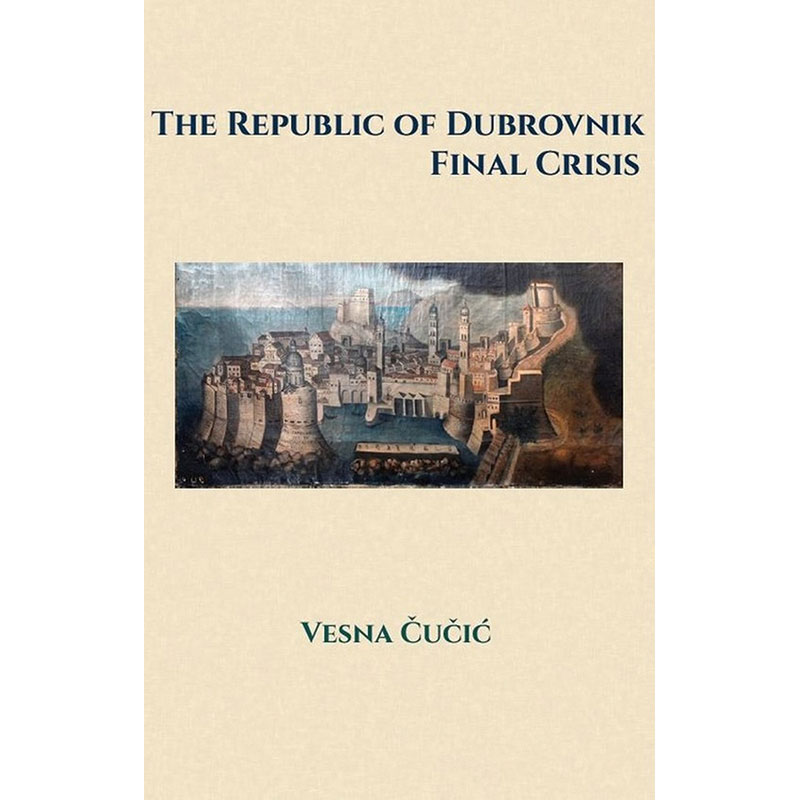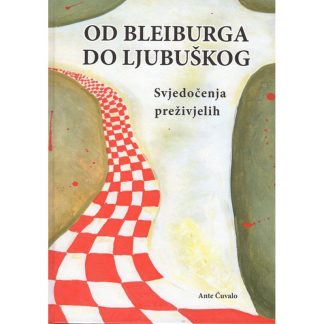Opis
DEDICATION
To my mother, Ane Kovacˇevic´, whose love and encouragement were indispensable in preparing this book.
ACKNOWLEDGMENTS
The English edition of this book has involved a number of people who gave generously of their time. This project could not have been accomplished without their enthusiasm, professionalism, and teamwork.
I am especially grateful to the following people for their valuable contributions during the development of this project: Ante Čuvalo for recognizing the value of the book and for organizing, coordinating, and guiding the whole project to its final result; Ikica Čuvalo for suggesting that an English translation be published, and for giving her time and input; Duško Čondić, a Chicago native, who invested much time and energy in the translation of the Croatian original; and Sabrina P. Ramet, for her professional comments. Additionally, I would like to thank Tomislav Kaniški, from the Lexicographic Institute in Zagreb, for drawing the maps, and Andjelka Kulaš for preparing the manuscript for print.
Once again, thanks to all who helped prepare this edition, and to all in the world who helped save this jewel of Croatian culture from destruction in 1806 and in 1991.
Vesna Čučić
FOREWORD
Just as in 1806, the city of Dubrovnik was under attack at the beginning of the 1990s. Sadly, both times the attackers were neighboring Montenegrins and Serbs from the eastern part of Herzegovina. Even the methods of destruction were similar on both occasions. In 1991, the whole world was able to see the images of the city being bombarded and in flames. The outcry of the civilized world saved the city, its people, and its great treasures from total destruction.
Nowadays, Dubrovnik is again in the news. Fortunately, this time it has become a great tourist destination. People from all over the world come to Dubrovnik to see its great historical treasures and enjoy themselves on the shores of the beautiful Adriatic Sea. This book will be a very valuable source to all English readers who are interested in the city of Dubrovnik and its history.
Two reasons serve as a motive for choosing this theme. On the one hand, the Croatian War of Independence (1991/1992) suggested a comparison with the war of 1806. Specifically, at the start of the 19th century, the small and neutral Republic of Dubrovnik disappeared after many centuries of existence, while the War of Independence brought the Republic of Croatia its contemporary beginnings, in which wounded and humiliated Dubrovnik, along with its ravaged environs, assumed its rightful place.
On the other hand, I was motivated by the fact that for a quite while no scholarly works of significance were published regarding the 1806 conflict of the great European powers on the territory of the Republic of Dubrovnik. The most important work dealing with the subject had its origin in Dubrovnik; namely, the book by Lujo Vojnović: Pad Dubrovnika [The Fall of Dubrovnik]. The work was written during the time of the Austro- Hungarian Empire, that is, while Dubrovnik and the rest of Croatia were still part of the Empire. From 1908, when Vojnović’s Pad was published, until today, some monumental events have taken place: the First and Second World Wars; the disappearance of the Austro-Hungarian Empire; the creation of the Kingdom of Serbs, Croats and Slovenes (renamed Yugoslavia in 1929) as a consequence of World War I and, after its various and bloody transformations, its demise; and finally a modern Republic of Croatia brought about by the War of Independence.
In light of these events, the questions are: how much opportunity existed to objectively write about the fall of the Republic of Dubrovnik in the intervening time?; secondly, was Vojnović, as a native of Dubrovnik, even able to write objectively about the events that led to the fall of the Republic or about those who caused its fall, about its darkest days? Even the horrendous earthquake of 1667-from which Dubrovnik was able to recover-does not equal the socio-political turmoil in Europe that adjudicated the end of the Republic of Dubrovnik.
For this reason it was important to seek out other points of view concerning problems in this period. It was necessary to bring to light the positions taken and the openly expressed as well as the hidden motives of all interested parties regarding the fate of Dubrovnik. As will become apparent, the existing literature and sources offer facts regarding the views, plans, and intentions of the Russians, Austrians, and the French. They also diminish the blame heaped upon the diplomacy of Dubrovnik for its poor efforts. As a result, the importance of the numerous debates and discussions found in the older literature concerning the efficacy of the diplomatic efforts on the part of Dubrovnik in its final stages is seen to be ameliorated.
Much has been written about the period that interests us presently concerning the problems intertwined in the diplomatic and political history of the period. Nonetheless, our intent was to explore within the context of the then contemporary European political and diplomatic situation, and from the perspective of a present-day point of view, the internal and external causes which led to the dissolution of the multi-century neutral city-state that was a bastion of Catholicism at the outer edge of the Ottoman Empire and in close proximity to Orthodoxy.
Of singular value among the foreign literature associated with this period is the work La Dalmatie de 1797 a 1815: Episode des conquetes Napoléoniennes from the year 1893. Its author is the French historian, Paul Pisani. In all likelihood, Vojnović leaned on this work. We also take note of the work by Kirchmayer written in Italian in 1900, La caduta della republica aristocratica di Ragusa. Both of these works, in their own way, are tendentiously colored and written from distinct points of view. The greatest value of the book The Ragusan Republic: Victim of Napoleon and Its Own Conservatism, the 1970 work by Harriet Towers-Bjelovučić, is to be found in the fact that it was written in English thus making it accessible to foreign scholars.
The literature treating the foreign policy of the Republic of Dubrovnik at the turn of the century is rather abundant. In particular, Bogdan Krizman, Lujo Vojnović, Mirko Deanović, Đuro Körbler, Ilija Mitić, Vuk Vinaver, and Vesna Miović Perić, specifically treated this subject.
The works of Žarko Muljačić, and the work Dubrovacˇke slike i prilike by Josip Bersa, were heavily used for the treatment of the topic of social conditions in Dubrovnik. Important works treating demographic movements in Dubrovnik are the studies of Vladimir Stipetić, Stjepan Krivošić, Stijepo Obad, and the recent investigative research of Nenad Vekarić and Niko Kapetanić.
The works of Žarko Muljačić are also heavily used in treating the political life of Dubrovnik. Recently, the joint work of Stjepan Ćosić and Nenad Vekarić, namely, Raskol dubrovacˇkog patricijata, appeared in print. It supplements and sheds light on the political battles during the time of the Republic.
The 1815 work published in French, namely, Memoire Bara Bettere austriskom generalu T. Milutinovic´u 1815, concerning economic questions in the Republic of Dubrovnik, is of great and significant value. This work was prepared for publication by Bogdan Krizman. The works of Vinko Ivančević, Josip Luetić, Stjepan Vekarić, and others, are also important sources.
Statistics relating to health measures are offered in the works of Risto Jeremić and Jorjo Tadić in their work entitled Prilozi za istoriju zdravstvene kulture starog Dubrovnika, and the work of Vladimir Bazala.
A significant number of authors have shown interest in religious adherence in Dubrovnik including Kosto Vojnović, Ante Marinović, and Ilija Mitić. Bernard Stulli and Zdravko Šundrica address the Jewish question, while Rade Vukomanović and Nikodim Milaš address the Orthodox question.
Regarding cultural and educational conditions, the works of the following authors are most heavily made use of: Žarko Muljačić, Rudolf Maixner, Zdravko Šundrica, Miho Demović, Slavica Stojan, Vicko Adamović, and others.
The central part of the book that deals with the war and its aftermath on the Republic of Dubrovnik makes heavy use of historical sources, some of which are published and some that are unpublished. Without the 1906 publication of the Italian diary of Francesco Maria Appendini, relating the events which took place in the war of 1806, it would have been impossible to shed light on the events treated in the chapter entitled: The War of 1806 on the Territory of the Republic of Dubrovnik. Two additional diaries are of importance: the manuscript found in the town of Cavtat in the possession of the Casilari family, and the diary of Miho Radilović, who was the parish priest in Orašac in the County of Slano. The manuscript by Ivo Matković is of special interest especially for the village of Duba in the area of Konavle. It exhaustively records many events and their participants of that time.
Another neutral witness of the Russian, Montenegrin, and Herzegovinian attacks on the City and its environs, namely, the Austrian Consul to Dubrovnik, Giovanni Timoni, zealously recorded those events. Only a small portion of those reports, written in French, has been published in Italian translation. Of exceptional value are the secret reports of an Austrian agent, Vinko Vlatković, a Dean in the Archdiocese of Zagreb, who was in residence in Dubrovnik during the year 1805. Parts of the report were published on two occasions in their original language, that is, in German by Tomo Matić. About the same time that Vlatković resided in Dubrovnik, the Polish nobleman Alexander Sapieha, one of the first double-agents in the world, also was in residence. His travelogue associated with Dubrovnik also served in this regard. Of interest for the Russian viewpoint are the secret reports to the Russian Imperial Court sent by the Russian Consul to Dubrovnik, Albanian Count, Antonio Ghika. These were published in 1991, in Sarajevo. Regarding the French point of view, the memoirs of Marshall Marmont are significant. A portion of the memoirs has been published in Croatian.
A section of the misplaced and forgotten account of war damages issued by the French Liquidation Commission (Commission de liquidation- Française), specifically for the County of Konavle and of Župa (including Brgat, Bosanka, and Šumet) and found in the State Archives of Dubrovnik, sheds supplemental light on the consequences of the war on the territory of the former Republic of Dubrovnik. Other than this census, the numerous series of reports in the State Archives of Dubrovnik served as sources. Among the most important are: Acta et Diplomata, Acta Consilii Rogatorum, Litterae et Commissiones Ponentis, and Litterae et Commissiones Levantis. The book Ispisi iz pariskih arhiva by Mihailo Gavrilović with its transcriptions from Archives in Paris cannot be overlooked. It is a printed source that serves as the basis for an analysis of French intentions toward Dubrovnik.
Microfilms of the correspondence of the French Consul to Dubrovnik with the Minister of Foreign Affairs in Paris serve as an extremely valuable source. They contain reports of some other Frenchmen in Dubrovnik and Bulletine that the French Consul regularly sent to the Ministry.
SUMMARY
The Republic of Dubrovnik experienced its last and greatest crisis in 1806. The crisis was so severe and complex that this centuries-old aristocratic Republic was, for the first time, unable to overcome it. The causes of the crisis were both external and internal. At the end of the 18th and the beginning of the 19th centuries, the Old Continent was in social turmoil, initiated by the French Revolution and the fear of the growing strength of the middle class in European countries. In the East, the Ottoman Empire was weakening. The great powers, particularly Russia and Austria, were working hard to further undermine its strength from within and to make eventual division of it easier. However, their efforts were frustrated by the rise of Napoleon. In his military expedition, he conquered the Eastern Adriatic Coast as well. His aggressiveness became a threat to British colonies, and, as a result, England had approached Russia to become allied with it. In the end, it succeeded.
During European Wars at the end of the 18th and the beginning of the 19th centuries-wars fought mainly because of the Eastern Question- the Republic of Dubrovnik enriched itself from its maritime trade. It was a neutral state, and ships under its flag were able to sail freely; in addition, they were protected by a Ferman granted by the Sultan. This economic prosperity, however, stood in divergence with the internal political situation of the Republic at that time, namely, the commoners, although the main protagonists in the renewal of maritime trade after the earthquake of 1667 were not yet allowed to participate in the Republic’s government. This class was further weakened by the fact that ten of its richest families were accepted into the ranks of the aristocracy. On the other hand, their presence in the governing class of aristocrats led to division among the aristocrats themselves. This division was mainly based on bloodlines and social status. Two groups resulted from this division: the salamankezi and the sorbonezi. Later, the division among aristocrats was also based on their affiliation with the Great European powers: Francophiles, Austrophiles, and Russophiles. The divisiveness among the aristocrats and their continued determination not to share power with the commoners made them less capable of confronting the complex set of problems facing the Republic. An additional factor contributed to the weakness of the aristocratic class. Restrictive marriage laws resulted in an ever-decreasing number of aristocratic descendants.
The strength of the Republic of Dubrovnik was not to be found in its military might but in the wealth of information at its disposal and its skillful use in carrying out its diplomacy with the East and West. It fostered good relations with everyone. It tried to maintain friendly relations with all and to find protectors among them. With those nations that were weak, it always remained cordial and polite and made efforts not to antagonize them. This strategy allowed the Republic to protect and preserve its statehood. Its relations with the Ottoman Empire, Spain, Austria, and the Papal States were especially good. The monetary tribute it paid to the Ottoman Empire since the 15th century served as the basis for its security. It was this very tribute that enabled the Republic to avoid subjugation by the Venetian Republic through the centuries.
The conduct of foreign policy by the Republic at the end of the 18th and beginning of the 19th century was made much more difficultbecause the European political situation changed and became quite complex. Before that period, the Republic was secure in its stable system of protection. However, with the rise of Napoleon and with the continued weakening of the Ottoman Empire, its main protector over the centuries, the Republic could not be so secure any longer. After the Treaty of Pressburg, according to which France gained the whole Eastern coast of the Adriatic, the Republic was formally surrounded by French possessions. However, the actual French possession of this region was delayed by the slow advancement of French troops through Dalmatia. This slow advance, caused by a number of different factors, allowed Russia to make a pre-emptive strike and occupy the Bay of Kotor at the beginning of March 1806. This was yet another ominous sign for the Republic of Dubrovnik. From this point forward and until May 27, the Republic was forced to abandon its foreign policy of neutrality and to choose sides with either the East or the West. It chose the West and allowed the French troops to pass through the City on their way to the Bay of Kotor. This was done with Napoleon’s assurance that the Republic would retain its autonomy.
Following the entrance of the French troops into the City, the war between the French and the Russians ensued. The Russians were allied with the Montenegrin paramilitary forces as well as supported by the neighboring Vlachs-Ottoman subjects who were members ofthe Orthodox Church. The main confrontation between the French and Russian forces took place in the region of Konavle. The fiercest battle engaged in by the French, one which exacted heavy casualties, took place on 17 June 1806 in the area of Brgat. Because of their heavy losses, the French withdrew to the safety of the City walls and remained there, surrounded by the enemy, until the arrival of General Molitor, who broke the siege on 6 July 1806. In the meantime, the allied Russian, Montenegrin and Vlach forces engaged in the wanton destruction of property and the killing of innocent inhabitants in their path. Along with this destruction, they continued to shell the City as well.
The Republic of Dubrovnik did not have much choice as to its course of action in 1806. Without any significant military strength and without the support of the great powers, the Republic, as a small state, found it impossible to remain neutral any longer. The only option open to the Republic was for it to take the side of one of the warring parties. Any other option was but an illusion. The Western option could have had a chance had the French arrived with a larger military force that could have been spread across the Republic’s entire territory. Clearly, neither France nor any other major power had any interest in preserving the independence of the Republic of Dubrovnik. Only Russia had such an interest-and then, only as a temporary measure. Russia was of the mind that its interests would best be served if Napoleon were prevented from possessing the entire Eastern shore of the Adriatic. Meanwhile, the events unfolding on the battlefields were in favor of Napoleon. With the breaking of the siege on Dubrovnik by General Molitor on July 6, the allied Russian and Montenegrin forces were beaten back. By the beginning of October, they were completely driven from the territories of the Republic by General Marmont. By that time, the Republic’s finances were totally exhausted because of wartime obligations and various loans made to the French. The fall of the Republic was imminent.
With the dissolution of the Republic of Dubrovnik by decree of General Marmont on 31 January 1808, the French administrative rule formally began. Some time later, a few of the aristocrats attempted to restore the Republic through a general uprising that had the support of both England and Austria. Both were keen to see the French leave the region. However, the attempt was unsuccessful. Nonetheless, Austria benefited by the attempt inasmuch as it facilitated the expulsion of the French from the territories of Dubrovnik. After the fall of Napoleon, the territory of the former Republic of Dubrovnik was given to the Hapsburg Monarchy by decree of the Congress of Vienna in 1815.
NOTE TO SCHOLARS AND READERS
Those who are interested in seeing an account of the atrocities and destruction in Dubrovnik and its vicinity committed by the Montenegrins, Herzegovinian Serbs, and Russians in 1806 can find a detailed report prepared by the French authorities at that time and published as an Appendix to the Croatian edition of this book: Vesna Čučić, Posljednja kriza Dubrovačke Republike. Zagreb; Dubrovnik: HAZU, Zavod za povijesne znanosti & Matica hrvatska Dubrovnik, 2003, pp. 197-261.





